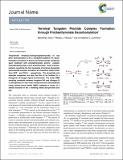Terminal tungsten pnictide complex formation through pnictaethynolate decarbonylation
Author(s)
Joost, Maximilian G; Transue, Wesley; Cummins, Christopher C
Downloadterminal_tungsten_pnictide.pdf (2.194Mb)
OPEN_ACCESS_POLICY
Open Access Policy
Creative Commons Attribution-Noncommercial-Share Alike
Terms of use
Metadata
Show full item recordAbstract
Tungsten(IV) tetrakis(2,6-diisopropylphenoxide) (1) has been demonstrated to be a competent platform for decarbonylative formation of anionic terminal pnictide complexes upon treatment with pnictaethynolate anions: cyanate, 2-phosphaethynolate, and 2-arsaethynolate. These transformations constitute the first examples of terminal phosphide and arsenide complex formation at a transition metal center from OCP− and OCAs−, respectively. The phosphide and arsenide complexes are also the first to be isolated in a tetragonal, all-oxygen ligand environment. The scalar NMR coupling constants between tungsten-183 and nitrogen-15 or phosphorus-31 have been measured and contextualized using natural bond orbital (NBO) methods in terms of s orbital character in the σ bonding orbital and pnictide lone pair.
Date issued
2017-09Department
Massachusetts Institute of Technology. Department of ChemistryJournal
Chemical Communications
Publisher
Royal Society of Chemistry
Citation
Joost, Maximilian, et al. “Terminal Tungsten Pnictide Complex Formation through Pnictaethynolate Decarbonylation.” Chemical Communications, vol. 53, no. 77, 2017, pp. 10731–33.
Version: Author's final manuscript
ISSN
1359-7345
1364-548X